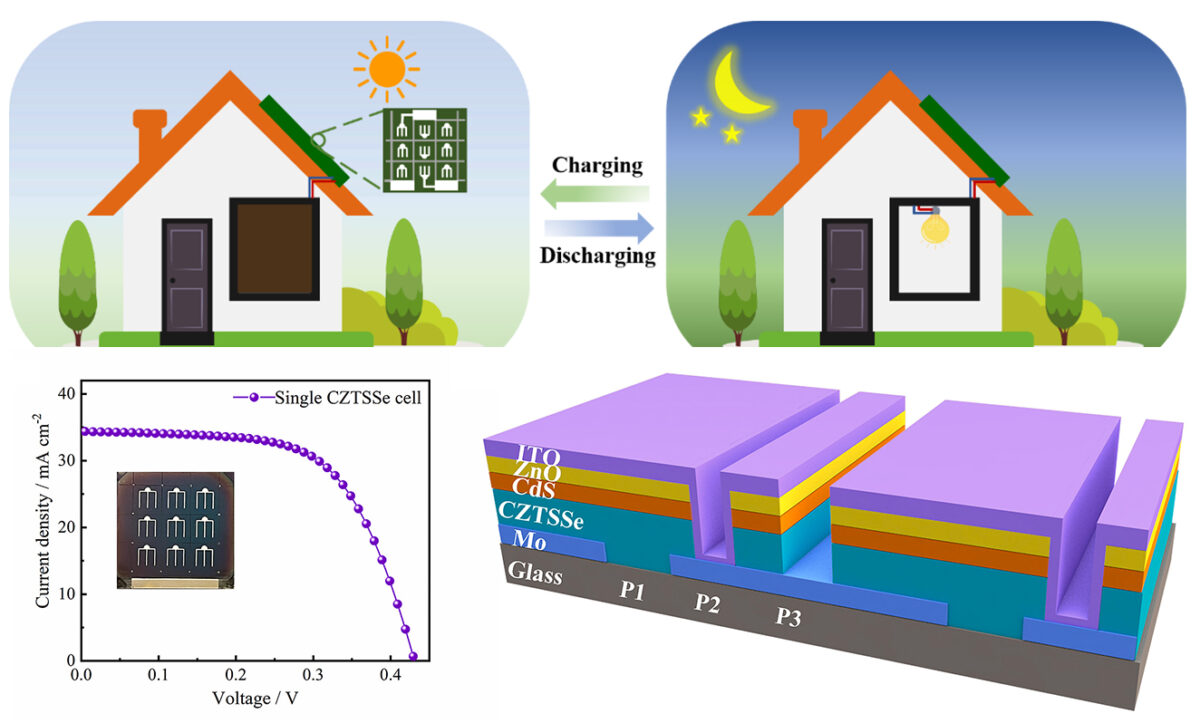Researchers led by Henan University in China have utilized kesterite (CZTSSe) thin-film solar cells in a new prototype of a smart solar window.
“Our prototype combines nickel-cobalt bimetal oxide (NiCoO2) electrochromic window and CZTSSe thin-film solar cells,” the research's lead author, Guofa Cai, told pv magazine. “Such an integrated prototype not only realizes the function integration of self-power and intelligent solar radiation adjustment, but also extends its function to energy storage.“
The scientists built the solar cell with a glass substrate coated with molybdenum (Mo), the kesterite absorber, a buffer layer based on cadmium sulfide (CdS), a layer of zinc oxide (ZnO), an indium tin oxide (ITO) layer deposited by magnetron sputtering, and silver (Ag) metal contacts.
They utilized a simple chemical bath deposition (CBD) strategy to prepare the NiCoO2 electrochromic films for the window. “Owing to the porous nanoflake array structure and the synergistic effect of nickel and cobalt elements, the NiCoO2 film and NiCoO2-based electrochromic smart windows exhibit excellent electrochemical, electrochromic as well as energy storage performance,” Cai explained.
The window also integrates a titanium oxide (TiO2) counter electrode film with a reportedly excellent performance of electrochromism and energy storage. This nanoparticle film acts as an ion storage layer owing to its good charge balance ability and high transmittance.
Tested under standard illumination conditions, the solar window showed an energy consumption of 318.3 mWh/m2 and an overall efficiency of 2.15%, which the team said are values comparable with most of the solar windows developed to date.
Popular content
“In particular, benefiting from the porous nanoflake arrays structure and the bimetallic synergistic effect, the NiCoO2 electrochromic films exhibit a large optical modulation, fast switching speed, outstanding electrochromic stability, as well as excellent rate capability,” they explained.
“The solar irradiation management performance of self-powered smart windows with neutral color tinting was studied for the first time, which is beneficial to improving the comfort of the occupants and makes it great potential in architectural applications,” Cai stated.
The cell technology and the window design were presented in the paper “Multi-functional electrochromic energy storage smart window powered by CZTSSe solar cell for intelligent managing solar radiation of building,” published in Solar Energy Materials and Solar Cells.
Kesterite is one of the most promising light absorber material candidates for potential use in lower-cost thin-film solar cells. Kesterites are comprised of common elements, such as copper, tin, zinc, and selenium. And unlike GIGS compounds, there are no supply bottlenecks expected in the future. However, kesterite is still less efficient than CIGS in mass production. The world record efficiency for such cells is 12.6%, achieved by Japanese thin-film producer Solar Frontier in 2013.
Smart windows and photovoltachromic devices (PVCDs) are capable of enabling adjustable transparency glazing and, at the same time, generate electricity by means of the PV effect. This technology has so far been applied to the design of self-powered smart windows for buildings and vehicles at research level; however, it is still at a very early stage of development. The ability to modulate indoor light and heat transmission, while generating energy from PVs, is enticing for further BIPV developments.
This content is protected by copyright and may not be reused. If you want to cooperate with us and would like to reuse some of our content, please contact: editors@pv-magazine.com.



6 comments
By submitting this form you agree to pv magazine using your data for the purposes of publishing your comment.
Your personal data will only be disclosed or otherwise transmitted to third parties for the purposes of spam filtering or if this is necessary for technical maintenance of the website. Any other transfer to third parties will not take place unless this is justified on the basis of applicable data protection regulations or if pv magazine is legally obliged to do so.
You may revoke this consent at any time with effect for the future, in which case your personal data will be deleted immediately. Otherwise, your data will be deleted if pv magazine has processed your request or the purpose of data storage is fulfilled.
Further information on data privacy can be found in our Data Protection Policy.